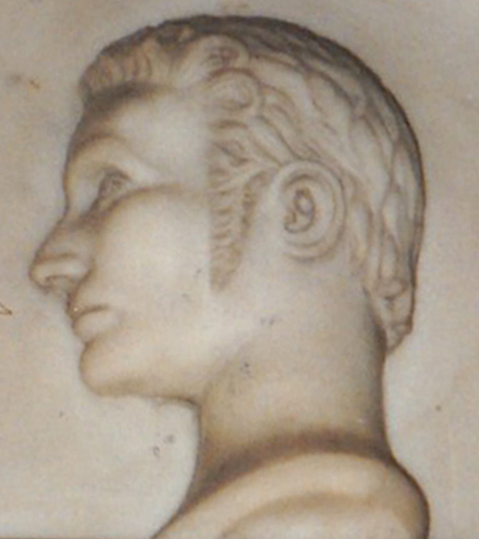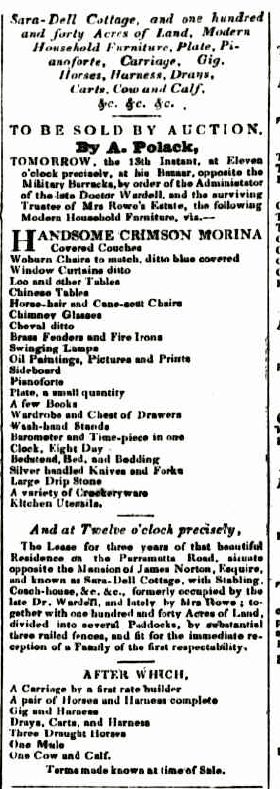The Dictionary of Sydney was archived in 2021.
Wardell, Robert
Citation
Persistent URL for this entry
To cite this entry in text
To cite this entry in a Wikipedia footnote citation
To cite this entry as a Wikipedia External link
Robert Wardell
Robert Wardell's achievements – [media]as founder of Australia's first independent newspaper, his career as a prominent Sydney lawyer, and his death at the hands of convicts – have been much written about, [1] but what has been less well covered is his personal life.
Wardell was born on 11 May 1793 at Healaugh in Yorkshire, England. In 1824 he sailed with his mother and niece for Sydney. Before undertaking the long sea journey, Robert made a will in which his mother was named as sole beneficiary. His niece, Jane Fisher, later married Alfred Potter and the couple went home to England.
Founder of Australia's first independent newspaper
[media]On board Wardell's ship to Sydney was William Charles Wentworth, with whom Wardell had been acquainted since 1819. In 1824, while working as editor of the London evening newspaper, The Statesman, Wardell recruited Wentworth to come to Sydney to start The Australian, Sydney's first independent newspaper, and a legal practice.
Of Wentworth and Wardell, their eventual enemy, Governor Ralph Darling said, 'Mr Wentworth and Dr Wardell…keep the Court and the Bar, by their effrontery and their talent, equally in subjection'. [2]
Life in Sydney
In Sydney, Wardell had a lucrative legal practice and he soon acquired an estate at Petersham. The 1828 census of NSW lists the residents of Sara Dell, Wardell's Petersham farm on the Parramatta Road: [3] Dr Wardell, came free; Mrs J Wardell, came free, age 60; Miss S Wardell, came free, age 25; Jane Fisher, came free, age 15 and the servants.
Of the mysterious 'Miss S Wardell' there are no records of arrival, departure or death. She was in fact Mrs Sarah Rowe, the wife of Thomas Deane Rowe, a shyster lawyer (also from Yorkshire) who had been in the colony since 1821 [4].
Sarah Rowe had followed her husband to Sydney in 1822, but soon all was not well between them. The Sydney Gazette of 3 July 1823 reported that Sarah Rowe ('wife of Mr Solicitor Rowe') had just departed – on her own – per Brixton for Europe, where she stayed for 18 months. [5] This is might be considered unlikely behaviour for a young wife, unless she had just discovered that her husband was having an affair with a woman called Harriet Hanks. [6]
Mills vs Rowe
Both Robert Wardell and Sarah Rowe arrived in Sydney in 1824, but on separate ships. Whether this was for discretion, or they were yet to meet, by 1828 the case of Mills v Rowe exposed Wardell's adultery with Rowe. [7] This strongly suggests that, as a litigant, Sarah had adopted her maiden name of Mills. Wardell's mistress was no mere convict servant but a 'came free' married woman of some social standing. As the pious Methodist George Allen wrote in his diary following Wardell's death, 'Alas the way in which he was living, in a state of adultery...leaves us without the least ray of hope' [8] – that is, for his salvation.
Sara Dell
[media]In the 1828 census, Thomas Deane Rowe (recorded as a solicitor, aged 37) and his mistress, Harriet Hanks, are recorded as living at Castlereagh Street but there is no mention of a 'Mrs S Rowe'. No doubt Wardell insisted on having Sarah recorded in the census as 'Miss S Wardell', his de facto wife at Sara Dell. Wardell's house was named after her as a word play on 'Sarah Wardell' – the wife she could never be – combined with the concept of a dell or small valley. We know from her death record that she was about 29 in 1828 – this is entirely consistent with her quoted age of 25. It was the census practice at the time to round down the true age of all adults to the nearest multiple of five, hence all those aged between 26 and 29 were recorded as being 25.
'Poison pen' letters
In 1832, Wardell sued his former employee Villiers Pearce for libel, and obtained a conviction. Pearce seems to have sent Sarah (and others) a poison pen letter, alleging a sexual scandal involving Wardell and the wife of his clerk. [9] At the trial, the letter was variously described as delivered to 'a person at Petersham', 'a branch of his household at Petersham' and 'a female residing in Dr Wardell's family'. [10] This female is most likely to have been Sarah Rowe.
The relationship between Robert and Sarah was undoubtedly a long one but was without legitimate issue. In an era before divorce, Wardell could neither marry Sarah nor include a woman whose husband was still very much alive in his will. Something that has always puzzled historians is why a lawyer like Wardell should die intestate – his mother had died in 1830 and a new will was never made – but this new insight into his domestic situation perhaps explains why he never remade his will.
Murder
[media]There is evidence that Wardell was preparing to sell up and return to England, presumably taking Sarah with him, when fate intervened. On 7 September 1834, three escaped convicts murdered Wardell about three quarters of a mile (just over one kilometre) from his home Sara Dell. [11] We do not know in which direction Wardell was riding at the time but this would put the site of the murder in a radius no further from the house than Marrickville Park or Newington College (although many accounts exaggerate the distance). Two of the convicts, including the ringleader John Jenkins, were executed and Wardell was given a grand funeral before being interred at Devonshire Street Cemetery.
Division of Wardell's estate
Before the division of Wardell's estate was settled in London, Wardell's old friend William Charles Wentworth – a sworn enemy of Thomas Rowe –managed his affairs locally. Whatever he thought of Sarah, Wentworth would have been only too pleased to allow Rowe's estranged wife to remain at Sara Dell as long as possible.
Back in London, Wardell's three married sisters were legally unable to own property in their own right, so in 1840, his brothers-in-law each got a third of the estate – not an outcome that would likely have pleased him. The brothers-in-law were: Charles Frederick Priddle of Chelsea, the husband of Jane Isabella Wardell, John Fisher of Fulham, husband of Ann(e) Fisher Wardell, and John Frazer of St Johns Wood, husband of Margaret Frazer Wardell. [12] Charles Priddle and his family chose to emigrate to Sydney, arriving in 1843. [13]
Death of Sarah
[media]Meanwhile, for three years after Wardell's death, Sarah continued to live at his town house in Upper Pitt Street and at Sara Dell. In September and October 1837, the 'Elegantly Furnished Cottage (now occupied by Mrs Rowe)' in Pitt Street was advertised 'to be let or sold', [14] but within two months, Sarah died at Petersham from an unknown cause, at only 38. No death or funeral notices were posted in the newspapers. She was buried on 8 December 1837 [15] and had not been in the ground for 24 hours when an advertisement appeared, offering for lease Sara Dell, the property 'occupied...lately by Mrs Rowe'. [16]
In a nice irony, both Robert Wardell and Thomas Deane Rowe were buried in the Devonshire Street Cemetery, with memorials erected to their names, but there is no record of Sarah's place of burial. She may have been discreetly buried near her lover but, when the Wardell family insisted on Robert's remains being disinterred and shipped to London to be buried next to his father in the family vault, it is clear that Sarah did not accompany him.
Death of Rowe
It was a mere three months after Sarah's death that her husband Thomas Deane Rowe was finally able to marry his long-time mistress Harriet Hanks, but it was to be a very short marriage. A few weeks later he was struck off the rolls. His career in tatters, he took his wife and family on a holiday to New Zealand (an overdue honeymoon, including their now legitimised sons) but upon his return, he died suddenly at Mittagong, aged 42 – all in the space of a few eventful months of 1838. [17]
References
C H Currey, 'Wardell, Robert (1793–1834)', Australian Dictionary of Biography, National Centre of Biography, Australian National University, http://adb.anu.edu.au/biography/wardell-robert-2773/text3941, viewed on 28 July 2012
John H Edwards, 'A Bloodstained Inheritance', Heritage, no 12, Marrickville Heritage Society, 2004
JM Wicks, 'An Assessment of the Colonial Career of Dr Robert Wardell, LLD, 1824–1834', BA Hons thesis, University of New England, 1970
Notes
[1] CH Currey, 'Wardell, Robert (1793–1834)', Australian Dictionary of Biography, National Centre of Biography, Australian National University, http://adb.anu.edu.au/biography/wardell-robert-2773, viewed 23 July 2012
[2] Letter from Governor Darling to Under Secretary Hay, 10 January 1828, Historical Records of Australia, p 694 http://arrow.latrobe.edu.au/store/3/4/9/0/6/public/B13858427S1V13pages477-726.pdf viewed 10 October 2017
[3] Wardell was 35, but no age was stated. His mother, Jane, was about 72. Jane Fisher was the niece of Dr Wardell.
[4] A scathing account of Rowe's legal career can be found at JM Bennett, A History of Solicitors in New South Wales, Legal Books, Sydney,1984, p 33
[5] The Sydney Gazette, 3 July 1823; Registry of Births, Deaths and Marriages, New South Wales Attorney General and Justice website, marriage record number V18381559 22/1838
[6] A later, spurious claim that Thomas and Harriet had married in 1823 suggests that this was when they began living together, a fact confirmed by the 1828 census, although they did not actually marry until 1838. See marriage record V18381559 22/1838
[7] Decisions of the Superior Courts of New South Wales, 1788–1899, Faculty of the Arts, Macquarie University website, http://law.mq.edu.au/research/colonial_case_law/nsw/cases/case_index/1828/mills_v_rowe_1828_sel_cas_dowling_500_1828_nswsupc_78/, viewed 23 July 2012
[8] George Allen, diary entry for 9th September 1834, George Allen papers, 1816–1875, Mitchell Library manuscript collection, State Library of New South Wales, MLMSS 477/1–4; CY 2575–CY 2578
[9] In those days, newspapers were discreet so the exact nature of the libel is impossible to discern, eg The Sydney Gazette of 22 November 1832 reported that 'the letter goes on to say **************. Mr. Foster is by repute a married man.'
[10] The Sydney Gazette, 16 August 1832
[11] Sara Dell was on the current site of Fort Street High School on the Parramatta Road, Sydney, and Wardell's Petersham estate stretched from there to the Cooks River. Hobart Town Courier, 26 September 1834
[12] Robert Wardell papers, 1793–1897, administration of the estate, 1841–1859, including pedigree of, and declarations concerning, heirs to the estate 1842, Mitchell Library manuscript collection, State Library of New South Wales, MLMSS A 5330
[13] Charles Priddle arrived in 1843, followed by his family in 1845; Sydney Morning Herald, 4 January 1843, Sydney Morning Herald, 7 January 1845
[14] The Sydney Monitor, 29 September 1837, et seq
[15] Registry of Births, Deaths and Marriages, New South Wales Attorney General and Justice website, burial registration number V18372353 21/1837
[16] The Sydney Gazette and New South Wales Advertiser, 9 December 1837
[17] JM Bennett, A History of Solicitors in New South Wales, Legal Books, Sydney, 1984, p 36
.






